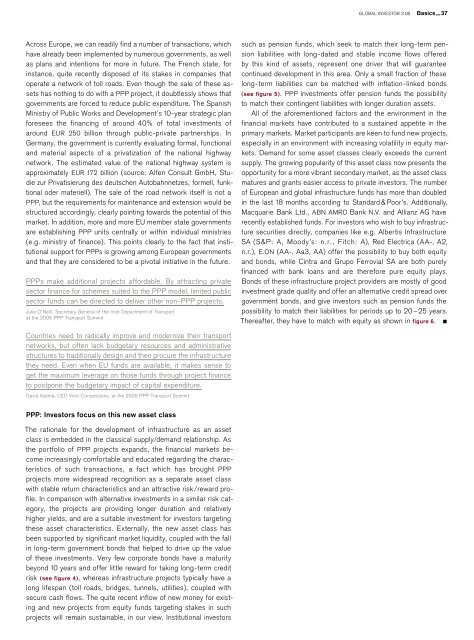Banking for 7 billion and 7 million
New challenges and opportunities of globalization Global Investor, 03/2006 Credit Suisse
New challenges and opportunities of globalization
Global Investor, 03/2006
Credit Suisse
Create successful ePaper yourself
Turn your PDF publications into a flip-book with our unique Google optimized e-Paper software.
GLOBAL INVESTOR 3.06 Basics — 37<br />
Across Europe, we can readily find a number of transactions, which<br />
have already been implemented by numerous governments, as well<br />
as plans <strong>and</strong> intentions <strong>for</strong> more in future. The French state, <strong>for</strong><br />
instance, quite recently disposed of its stakes in companies that<br />
operate a network of toll roads. Even though the sale of these assets<br />
has nothing to do with a PPP project, it doubtlessly shows that<br />
governments are <strong>for</strong>ced to reduce public expenditure. The Spanish<br />
Ministry of Public Works <strong>and</strong> Development’s 10-year strategic plan<br />
<strong>for</strong>esees the financing of around 40% of total investments of<br />
around EUR 250 <strong>billion</strong> through public-private partnerships. In<br />
Germany, the government is currently evaluating <strong>for</strong>mal, functional<br />
<strong>and</strong> material aspects of a privatization of the national highway<br />
network. The estimated value of the national highway system is<br />
approximately EUR 172 <strong>billion</strong> (source: Alfen Consult GmbH, Studie<br />
zur Privatisierung des deutschen Autobahnnetzes, <strong>for</strong>mell, funktional<br />
oder materiell). The sale of the road network itself is not a<br />
PPP, but the requirements <strong>for</strong> maintenance <strong>and</strong> extension would be<br />
structured accordingly, clearly pointing towards the potential of this<br />
market. In addition, more <strong>and</strong> more EU member state governments<br />
are establishing PPP units centrally or within individual ministries<br />
(e.g. ministry of finance). This points clearly to the fact that institutional<br />
support <strong>for</strong> PPPs is growing among European governments<br />
<strong>and</strong> that they are considered to be a pivotal initiative in the future.<br />
PPPs make additional projects af<strong>for</strong>dable. By attracting private<br />
sector finance <strong>for</strong> schemes suited to the PPP model, limited public<br />
sector funds can be directed to deliver other non-PPP projects.<br />
Julie O’Neill, Secretary General of the Irish Department of Transport<br />
at the 2005 PPP Transport Summit<br />
such as pension funds, which seek to match their long-term pension<br />
liabilities with long-dated <strong>and</strong> stable income flows offered<br />
by this kind of assets, represent one driver that will guarantee<br />
continued development in this area. Only a small fraction of these<br />
long-term liabilities can be matched with inflation-linked bonds<br />
(see figure 5). PPP investments offer pension funds the possibility<br />
to match their contingent liabilities with longer duration assets.<br />
All of the a<strong>for</strong>ementioned factors <strong>and</strong> the environment in the<br />
financial markets have contributed to a sustained appetite in the<br />
primary markets. Market participants are keen to fund new projects,<br />
especially in an environment with increasing volatility in equity markets.<br />
Dem<strong>and</strong> <strong>for</strong> some asset classes clearly exceeds the current<br />
supply. The growing popularity of this asset class now presents the<br />
opportunity <strong>for</strong> a more vibrant secondary market, as the asset class<br />
matures <strong>and</strong> grants easier access to private investors. The number<br />
of European <strong>and</strong> global infrastructure funds has more than doubled<br />
in the last 18 months according to St<strong>and</strong>ard & Poor’s. Additionally,<br />
Macquarie Bank Ltd., ABN AMRO Bank N.V. <strong>and</strong> Allianz AG have<br />
recently established funds. For investors who wish to buy infrastructure<br />
securities directly, companies like e.g. Albertis Infrastructure<br />
SA (S&P: A, Moody’s: n.r., Fitch: A), Red Electrica (AA-, A2,<br />
n.r.), E.ON (AA-, Aa3, AA) offer the possibility to buy both equity<br />
<strong>and</strong> bonds, while Cintra <strong>and</strong> Grupo Ferrovial SA are both purely<br />
financed with bank loans <strong>and</strong> are there<strong>for</strong>e pure equity plays.<br />
Bonds of these infrastructure project providers are mostly of good<br />
investment grade quality <strong>and</strong> offer an alternative credit spread over<br />
government bonds, <strong>and</strong> give investors such as pension funds the<br />
possibility to match their liabilities <strong>for</strong> periods up to 20 – 25 years.<br />
Thereafter, they have to match with equity as shown in figure 6. <br />
Countries need to radically improve <strong>and</strong> modernize their transport<br />
networks, but often lack budgetary resources <strong>and</strong> administrative<br />
structures to traditionally design <strong>and</strong> then procure the infrastructure<br />
they need. Even when EU funds are available, it makes sense to<br />
get the maximum leverage on those funds through project finance<br />
to postpone the budgetary impact of capital expenditure.<br />
David Azema, CEO Vinci Concessions, at the 2005 PPP Transport Summit<br />
PPP: Investors focus on this new asset class<br />
The rationale <strong>for</strong> the development of infrastructure as an asset<br />
class is embedded in the classical supply/dem<strong>and</strong> relationship. As<br />
the portfolio of PPP projects exp<strong>and</strong>s, the financial markets become<br />
increasingly com<strong>for</strong>table <strong>and</strong> educated regarding the characteristics<br />
of such transactions, a fact which has brought PPP<br />
projects more widespread recognition as a separate asset class<br />
with stable return characteristics <strong>and</strong> an attractive risk/reward profile.<br />
In comparison with alternative investments in a similar risk category,<br />
the projects are providing longer duration <strong>and</strong> relatively<br />
higher yields, <strong>and</strong> are a suitable investment <strong>for</strong> investors targeting<br />
these asset characteristics. Externally, the new asset class has<br />
been supported by significant market liquidity, coupled with the fall<br />
in long-term government bonds that helped to drive up the value<br />
of these investments. Very few corporate bonds have a maturity<br />
beyond 10 years <strong>and</strong> offer little reward <strong>for</strong> taking long-term credit<br />
risk (see figure 4), whereas infrastructure projects typically have a<br />
long lifespan (toll roads, bridges, tunnels, utilities), coupled with<br />
secure cash flows. The quite recent inflow of new money <strong>for</strong> existing<br />
<strong>and</strong> new projects from equity funds targeting stakes in such<br />
projects will remain sustainable, in our view. Institutional investors

















